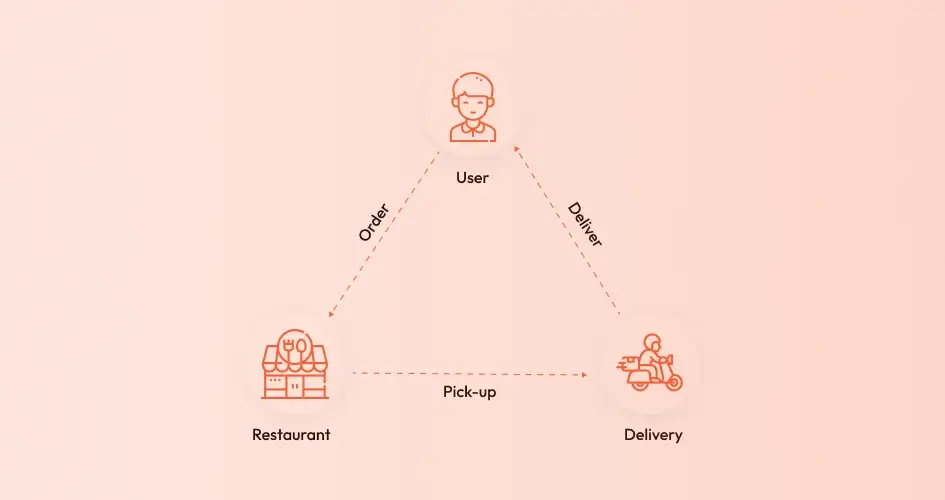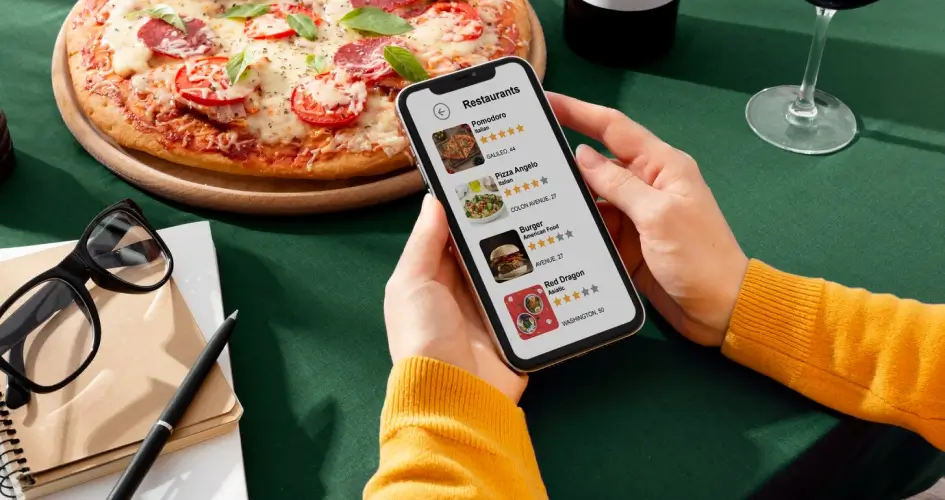So you’ve consulted a food delivery app development company, built a custom app tailored to your needs, and got your food delivery business up and running.
But, you’re constantly wondering, is my business performing well?
Without key performance indicators (KPIs), measuring the success of your food delivery business is almost impossible.
That’s why, in this article, we’ll dive deep into the topic of food delivery KPIs.
These metrics will give you the needed guidance to identify areas of improvement and deliver top-notch food delivery services.
Key Performance Indicators for Food Delivery Businesses
Running a thriving food delivery company requires careful monitoring of key performance metrics to ensure operational efficiency, customer satisfaction, and overall business growth.
From measuring your delivery operations to keeping a good look at customer satisfaction trends, this section will explain all the important food delivery performance KPIs you need to know.
Looking to build a top-notch food delivery app? Book your 30-minute FREE consultation with Intelivita to explore growth opportunities today!
#1. Order Preparation Time
The time it takes to process and deliver an order is a critical key performance indicator.
Longer delivery times can lead to customer dissatisfaction, and before you know it, your food delivery business is losing sales.
How to Measure
To calculate your average order processing time, let’s break down the entire delivery process into specific stages:
- Order placement time – The clock starts ticking from the moment a customer places an order through your food delivery app.
- Restaurant processing time – Measure how long the restaurant or kitchen processes the order.
- Dispatch time – Once ready, track the time the restaurant needs to handover the meals to the assigned delivery driver.
- Delivery time – Calculate the actual time it takes for the delivery partner to reach the customer’s location from the dispatch point.
Take samples of orders with varying delivery routes to better understand your order processing performance.
Once you’ve collected the data, measure the average delivery time by dividing the total time with the total number of deliveries.
Let’s say you have three deliveries completed within a specific period, and each has different variables:
- 2-mile delivery completed in 10 minutes
- 5-mile delivery completed in 20 minutes
- 10-mile delivery completed in 40 minutes
In this case, your average time would be around 23 minutes.
The next step is to compare your average delivery time with the industry benchmarks and customer expectations.
As a general rule of thumb, Statista revealed that 38% of consumers want their food to be delivered within 21 to 30 minutes.
So, if your average delivery speed exceeds the threshold, you need to come up with better strategies to boost the delivery performance KPI.
Create efficient delivery routes, manage delivery drivers, save operational costs, and ensure on-time deliveries with our delivery management software.

2. Order Accuracy
Ensuring that your orders are accurate is vital to maintain high customer satisfaction.
Incorrect orders and failed deliveries can lead to customer complaints and negative reviews on app stores.
In the long term, your food delivery business will experience a decline in customer loyalty, resulting in fewer app downloads and monetary loss.
How to Measure Order Accuracy
First, you need to define what constitutes an accurate order clearly.
This could include the correct items, quantity, and other special requests.
It’s also important to decide on a clear KPI for this metric.
For example, you may set a 95% or higher accuracy target.
Next, collect data on the total number of orders processed during a specific time period.
Obtain this information from order records and sales reports.
Once you’ve determined the number of orders that meet the criteria for accuracy based on your definition, use this formula to measure the accuracy percentage:
(Total number of orders/number of accurate orders) X 100 = % order accuracy
So, if your total orders are 50 and 45 of them are accurate, your order accuracy value is 90%.
Since this number is still lower than your target, evaluate your current order fulfillment process to identify the bottlenecks and find ways to improve.
Here are some best practices to keep your order accuracy high:
- Perform quality control: Establish QC procedures at different stages of the order process, from receiving the order to packing and dispatching. Double-check items against the order and ensure proper packaging.
- Implement technology: Use order management software and point-of-sale (POS) systems that can help automate the tracking and verification of orders.
- Train staff: Provide ongoing training to your employees, including handling different types of orders, communicating effectively with customers, and using software to maintain order accuracy.
3. Customer Retention Rate
The ability to retain users is a key indicator of your service’s quality.
A high retention rate implies that your food delivery business can meet customer demand and keep them returning for more.
How to Measure
Determine the time period you want to calculate the customer retention rate.
It could be a month, quarter, or year.
After that, collect the following data:
- Total users at the start of the chosen period
- New users acquired during that time frame
- Your current number of customers
Use this formula to calculate your customer retention rate:
(Number of customers at the end – new users acquired) / (total users at the start) X 100 = % retention rate
For example, you had 143 customers a month ago.
In that period, you lose 5 and gain 20 new users, making your current number of customers stand at 158.
If we apply the formula, your retention rate will be (158 – 20) / (143) X 100 = 96,5%.
According to a recent study, the average customer retention rate in the food delivery industry is between 70-80%.
That said, you should always aim for a higher rate.
This shows your dedication to improving your app’s overall performance and keeping customer satisfaction high.
Here’s how:
- Exceptional customer service. Provide responsive and helpful customer support to address users’ problems promptly.
- Loyalty programs. Reward loyal customers by offering discounts, free items, or other exclusive benefits.
- Personalization. Use data analytics to understand customer preferences, then offer personalized menu recommendations.
- Feedback collection. Encourage customers to leave honest feedback. Use these reviews to make improvements and show customers their opinions matter.
4. Average Order Value (AOV)
This metric measures the average money spent in a single transaction on your food delivery platform.
A higher AOV indicates that customers are spending more per order, contributing to increased revenue.
Understanding AOV is also crucial in shaping your marketing strategies.
When you know how much profit a single order brings, it’s easier to allocate a promotional budget to increase sales, such as offering free shipping or discounts.
How to Measure AOV
The first step is gathering the total revenue generated and orders delivered during a given period.
Depending on your business needs, it could be daily, weekly, monthly, or annually.
Afterward, calculate the average amount spent per customer’s order using this simple formula:
(Total revenue/number of orders) = average order value
Let’s say your food delivery service generated $10,000 in revenue from 500 orders in a month.
This means the average order value is $20.
You can calculate AOV for specific customer segments or marketing channels to gain deeper insights into user behavior.
For instance, if your AOV from Instagram ads is higher than email newsletters, it may indicate that social media users are more likely to make larger purchases.
With this in mind, you can tailor your marketing strategies to attract more customers from Instagram and other social platforms.
5. Customer Satisfaction (CSAT) Score
CSAT scores provide valuable insights into how pleased users are with your food delivery service.
Satisfied customers are more likely to leave positive reviews online and recommend your business to their friends, family, and colleagues, bringing in more sales.
A flawless in-app experience is a key factor that directly impacts user satisfaction.
When building a food delivery app, find a reliable software agency that prioritizes a user-friendly interface and performs robust security measures in app development.
How to Calculate a Customer Satisfaction Score
Start with a simple survey by asking customers: “How would you rate your satisfaction with our service?” and provide a scale from 1 to 5.
Send the survey after a specific interaction, purchase, or service request. Use various channels like email, social media, or in-app surveys for accessibility.
After collecting enough responses, measure your CSAT using this formula:
(Number of positive responses / total number of responses) X 100 = % CSAT score
When using a 5-point scale, consider 4 and 5 as positive ratings.
So, if you receive 80 positive responses out of 100, your CSAT score would be (80 / 100) X 100 = 80%.
That number is pretty good, considering that the typical CSAT benchmarks are between 75-80%.
6. Delivery Cost as a Percentage of Revenue
This key performance indicator assesses the proportion of a company’s revenue spent on delivery-related expenses.
Managing delivery costs is crucial for operational efficiencies.
Tracking this metric, you can find solutions for cost savings and keep delivery expenses within sustainable limits for maximum profitability.
Understanding your business’s profitability is crucial. Regularly reviewing profit and loss statements helps identify areas where expenses can be reduced and revenues increased. Using a free profit and loss template can simplify this process, providing clear insights into your financial performance.
How to Measure
Determine the total delivery costs on a given period.
Those include vehicle maintenance, fuel costs, driver wages, and other external factors affecting your delivery processes.
Then, sum up all revenue generated during the same time frame.
Divide the total delivery costs by total revenue and multiply the result by 100 to get the percentage:
(Total delivery costs / total revenue) X 100 = % delivery cost
Let’s say your business spends $10,000 on delivery costs monthly and generates $50,000 in
revenue during the same period.
In this scenario, ($10,000 / $50,000) x 100 = 20% of your total sales is allocated to cover delivery costs.
A lower percentage indicates efficient cost management, while a higher value suggests a need for cost optimization and delivery efficiency methods.
Regularly assessing and optimizing this metric, your business can strike a balance between offering reliable delivery services and maintaining financial sustainability.
7. Driver Performance
Your delivery personnel is the face of your company.
After all, they’re the ones who interact directly with customers – positive interactions and professional conduct can contribute to a positive brand image.
How to Measure
Driver performance can be assessed based on multiple factors rather than a single numerical formula.
That said, you can measure each aspect individually:
- Delivery time. Analyze the average time it takes for a driver to complete a delivery. This should not include the restaurant’s preparation time.
- Completed deliveries. Evaluate the percentage of orders completed and accurate and timely deliveries.
- Customer ratings. Collect and analyze customer feedback and ratings specific to each delivery team member. Highlight areas for improvement for low-rated drivers and give rewards to good-performing personnel.
- Adherence to safety guidelines. Ensure your drivers comply with safety guidelines, including traffic rules and hygiene standards.
Improve Your Food Delivery Performance With Software
Measuring your food delivery KPIs is one thing, but ensuring your business keeps hitting the target consistently is a different ball game.
To make the process a lot easier, there are plenty of applications that you should consider:
- Route optimization software: Deliver food faster and help drivers spend less on gas with optimized routes.
- Point of Sale (POS) system: A POS system enables secure and seamless transactions if you’re running a restaurant or cafe. It also allows you to track the purchase history and identify patterns in customer behavior.
- Food delivery app: While there are many reasons why your business needs a delivery app, the most important one is to reach customers in and around your area. The process of ordering, preparing, and delivering food to the customer’s door is done within a single app.
Looking for a reliable food delivery app development agency?
Look no further than Intelivita.
With a decade of trial and error, we have found the perfect antidote to your app development woes.
Contact our experts today, and let’s bring your food delivery business to the next level!




